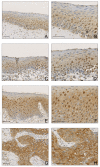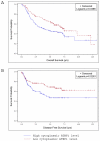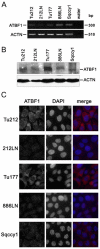Interruption of nuclear localization of ATBF1 during the histopathologic progression of head and neck squamous cell carcinoma
- PMID: 22791392
- PMCID: PMC3978689
- DOI: 10.1002/hed.23077
Interruption of nuclear localization of ATBF1 during the histopathologic progression of head and neck squamous cell carcinoma
Abstract
Background: The AT-motif binding factor 1 (ATBF1) gene is frequently altered at the genetic level in several types of cancer, but its protein expression and subcellular localization have not been well studied in human cancers, including head and neck squamous cell carcinomas (HNSCCs).
Methods: ATBF1 expression and localization were examined in 5 cell lines and 197 clinical specimens of HNSCC, and correlated with pathologic and clinical characteristics.
Results: ATBF1 was predominantly localized in the nucleus of hyperplastic squamous epithelium. Whereas nuclear ATBF1 dramatically decreased in invasive tumors (p = .0012), cytoplasmic ATBF1 levels progressively increased from dysplasia to invasive tumors (p < .0001), and the increase correlated with poor survival. Reduced nuclear ATBF1 level was also detected in HNSCC cell lines.
Conclusions: Nuclear localization of ATBF1 is frequently interrupted in HNSCC, and the interruption is significantly associated with the progression of HNSCC. The cytoplasmic ATBF1 level could be useful for predicting patient survival.
Copyright © 2012 Wiley Periodicals, Inc.
Figures



Similar articles
-
A diagnostic marker for superficial urothelial bladder carcinoma: lack of nuclear ATBF1 (ZFHX3) by immunohistochemistry suggests malignant progression.BMC Cancer. 2016 Oct 18;16(1):805. doi: 10.1186/s12885-016-2845-5. BMC Cancer. 2016. PMID: 27756245 Free PMC article.
-
Downregulation and translocation of nuclear ING4 is correlated with tumorigenesis and progression of head and neck squamous cell carcinoma.Oral Oncol. 2011 Mar;47(3):217-23. doi: 10.1016/j.oraloncology.2011.01.004. Oral Oncol. 2011. PMID: 21310648
-
Downregulation of nuclear ING3 expression and translocalization to cytoplasm promotes tumorigenesis and progression in head and neck squamous cell carcinoma (HNSCC).Histol Histopathol. 2020 Jul;35(7):681-690. doi: 10.14670/HH-18-197. Epub 2019 Dec 30. Histol Histopathol. 2020. PMID: 31886514
-
Elevated expression of iASPP in head and neck squamous cell carcinoma and its clinical significance.Med Oncol. 2012 Dec;29(5):3381-8. doi: 10.1007/s12032-012-0306-9. Epub 2012 Jul 20. Med Oncol. 2012. PMID: 22815155
-
Nuclear entrapment of p33ING1b by inhibition of exportin-1: A trigger of apoptosis in head and neck squamous cell cancer.Cell Mol Biol (Noisy-le-grand). 2018 Apr 30;64(5):66-72. Cell Mol Biol (Noisy-le-grand). 2018. PMID: 29729696
Cited by
-
Characterization of nuclear localization and SUMOylation of the ATBF1 transcription factor in epithelial cells.PLoS One. 2014 Mar 20;9(3):e92746. doi: 10.1371/journal.pone.0092746. eCollection 2014. PLoS One. 2014. PMID: 24651376 Free PMC article.
-
SUMOylation of the transcription factor ZFHX3 at Lys-2806 requires SAE1, UBC9, and PIAS2 and enhances its stability and function in cell proliferation.J Biol Chem. 2020 May 8;295(19):6741-6753. doi: 10.1074/jbc.RA119.012338. Epub 2020 Apr 5. J Biol Chem. 2020. PMID: 32249212 Free PMC article.
-
ATBF1 is a potential diagnostic marker of histological grade and functions via WNT5A in breast cancer.BMC Cancer. 2022 Dec 7;22(1):1280. doi: 10.1186/s12885-022-10380-2. BMC Cancer. 2022. PMID: 36476423 Free PMC article.
-
ATBF1 Participates in Dual Functions of TGF-β via Regulation of Gene Expression and Protein Translocalization.Biomolecules. 2020 May 24;10(5):807. doi: 10.3390/biom10050807. Biomolecules. 2020. PMID: 32456355 Free PMC article.
-
A diagnostic marker for superficial urothelial bladder carcinoma: lack of nuclear ATBF1 (ZFHX3) by immunohistochemistry suggests malignant progression.BMC Cancer. 2016 Oct 18;16(1):805. doi: 10.1186/s12885-016-2845-5. BMC Cancer. 2016. PMID: 27756245 Free PMC article.
References
-
- Jemal A, Siegel R, Xu J, Ward E. Cancer statistics, 2010. CA Cancer J Clin. 2010;60(5):277–300. - PubMed
-
- Miura Y, Tam T, Ido A, et al. Cloning and characterization of an ATBF1 isoform that expresses in a neuronal differentiation-dependent manner. J Biol Chem. 1995;270(45):26840–8. - PubMed
-
- Ido A, Miura Y, Tamaoki T. Activation of ATBF1, a multiple-homeodomain zinc-finger gene, during neuronal differentiation of murine embryonal carcinoma cells. Dev Biol. 1994;163(1):184–7. - PubMed
Publication types
MeSH terms
Substances
Grants and funding
LinkOut - more resources
Full Text Sources
Medical

